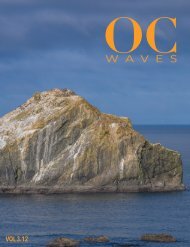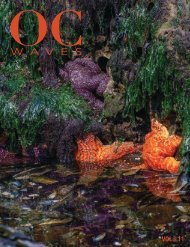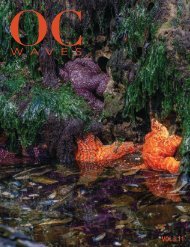You also want an ePaper? Increase the reach of your titles
YUMPU automatically turns print PDFs into web optimized ePapers that Google loves.
TRAPPERS<br />
PURSE SEINES<br />
THE NETS<br />
<strong>OC</strong> <strong>WAVES</strong> • VOL <strong>3.9</strong><br />
TRAPPING CRAB<br />
Dungeness crabbing is seasonal, usually from December 1 to August 15. The majority of the catch<br />
occurs during the first two months of the season. Most vessels participate in a combination of<br />
other fisheries during various times of the year.<br />
Crabbers are rigged with a large hydraulic block (crab block or gurdy). Mounted just behind the<br />
pilot house, it is used to haul in pots. Because the catch is delivered to the market live, the vessels<br />
have a circulating seawater system in their holds. Most pots are circular, measure three to four<br />
feet across, and weigh from 75 to 120 pounds. The 3⁄4-inch welded steel frames are wrapped with<br />
strips of used inner tube to protect the steel from corrosion. Stainless steel wire is used to weave a<br />
three- to four-inch-diameter mesh over the wrapped frame. Tunnels on opposite sides allow crabs<br />
to enter the trap. The traps are baited with herring, squid, or razor clams. A ring on the top side<br />
gives undersized crabs an escape route. A single line with usually two cylindrical plastic buoys is<br />
attached to the trap. Buoys are marked or colored to distinguish one vessel’s pots from another.<br />
Each fisherman has an ODFW-registered number on the bouys.<br />
Crab boats typically have a two- to four-person crew. The crew pushes the pots over one at a time<br />
as the vessel follows a particular depth line, usually between 3 and 80 fathoms (a fathom equals<br />
six feet). Pots are retrieved one at a time by snagging the buoy line with a hooked pole. The<br />
line is placed in the block, which hauls the pot into the vessel. Each vessel is allowed to fish a<br />
certain maximum number of pots (check current regulations). When the traps come up, they are<br />
emptied, the catch is sorted, and the pot is rebaited and put back out. A two-person crew can<br />
average 30 to 40 pots an hour. Traps can hold up to 60 crabs. Crab pots are checked every one to<br />
seven days, depending on fishing conditions.<br />
MANAGING THE CRAB FISHERY<br />
The fishery is managed with limited entry permits (fishermen need a permit to fish for crabs, and<br />
only 450 permits are issued for this fishery). Furthermore, the fishery is managed by size and sex<br />
restrictions, ensuring a healthy population. Only male crabs are harvested, and the shell on the<br />
crab has to be at least 6 1⁄4 inches. This size is reached at four years of age and allows the crab to<br />
reproduce for one to two years before being harvested. The crabs can live to be 9 to 10 years old.<br />
Landings of Dungeness crab range from 3 million to 18 million pounds, with the average catch<br />
at 10 million. Dungeness crab populations fluctuate a great deal from year to year, depending on<br />
oceanographic conditions. Dungeness crab rivals Maine lobster as a gourmet item, and in recent<br />
years a live crab market has developed.<br />
Purse seines, or movable nets, are used to encircle fishThe<br />
top of the net is a float line with corks, or buoys. The net is<br />
held in a vertical position by a weighted lead line. The net also<br />
has a wire cable, run through ringson the bottom, which is<br />
used to draw the net together. Purse seine fishers often use<br />
spotter planes and sonar to locate the fish. Once the school is<br />
located, a small skiff takes one end of the net and then circles<br />
the fish with the net. The wire cable is winched in to close off<br />
the bottom of the seine. Then the other lines are pulled in as<br />
well to bring the captured school of fish closer to the mother<br />
ship, where the fish are pumped out of the net and put into<br />
fish holds filled with refrigerated sea water.<br />
THE VESSELS<br />
Purse seine vessels are in the 60- to 85-foot range. A typical<br />
catch is 35 or 40 tons, and vessels are able to fill their hold<br />
with one or two sets. Seine boats are recognized at the dock by<br />
having on their stern a smaller skiff that is used to pull the net<br />
around the schools of fish. The skiff usually has a prop guard<br />
to keep the net from getting tangled in the propeller.<br />
THE PACIFIC SARDINE FISHERY<br />
Purse seines are used to catch schooling species such as<br />
mackerels, sardines, and anchovies. A purse seine fishery<br />
for Pacific sardines resumed on the Oregon coast in 1999. In<br />
2001, just over 28 million pounds were landed. Most of the<br />
sardines landed in Oregon are exported. Much of the harvest<br />
ends up in Japan as bait for the longline fishery or for human<br />
consumption. Only the highest-quality fish are used as bait.<br />
There is potential to further develop the sashimi market<br />
in Japan (sashimi is a dish consisting of raw fish cut in thin<br />
slices and served with sauce). In 2001, 20 percent of the catch<br />
was shipped to Australia as feed for tuna farms. Only a small<br />
amount of the catch is sold in Oregon, usually to high-end<br />
restaurants in Portland.<br />
13
















